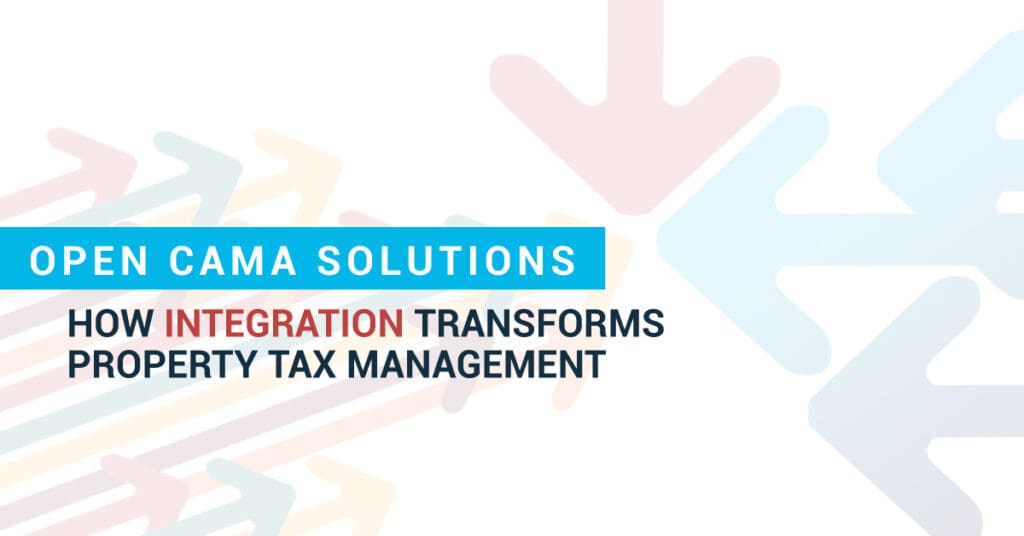A majority of property tax assessors believe integration is key to improving their current CAMA software. In a previous blog post titled “3 CAMA Software Pitfalls Property Tax Assessors Should Avoid,” we touched on this subject and discussed the downside of software that doesn’t integrate with best-in-industry tools. Today, we’ll explain what integration actually is, how it works, and why it matters so much.
Software Integration Defined
Software integration, in a nutshell, is the process of getting different types of software, or multiple sub-systems, to work together as one unified system. In some cases, the various types of software or sub-systems are created by the same company. In others, these unique pieces are created by different companies. In all cases, the parts must work together as one efficient system — and they are able to do that through the process of integration.
Types of Software Integration
Integration comes in three “flavors” in the context of property tax assessment software.
Integration between and among a CAMA vendor’s own products:
CAMA products are used for a myriad of functions, and a vendor’s products should work together harmoniously. A vendor may have different offerings for real property, personal property, assessment, appeals, and billing, for example. But those offerings are only helpful to the extent they accurately mirror workflow in the field, streamline communications (including both data entry and data access), and share essential information across functions. CAMA software that effectively integrates all its relevant property tax assessment pieces facilitates these critical information flows.
The Appeals module of our Arist tailored software solution is one simple example of how this type of integration works. Appeals does more than just capture and track information from an individual’s initial application. Closely tied into our other Arist modules, it also makes that information available to the appraiser who may need to reassess the property, incorporates any reappraisal information into the record for presentation to the board of equalization, records the board’s decision, and reflects any resulting changes in a new property tax value. Behind the scenes, this all works because we’ve integrated the Appeals module with other modules that handle appraisal, assessment, and billing.
Integration of a CAMA vendor’s products with other vendors’ products:
Geographic information systems (GIS). Aerial imagery. Building sketch tools. Industry cost data services. Artificial intelligence solutions. These are items typically found on an assessor’s wish list, and some CAMA vendors provide their own versions of these add-ons. Unfortunately, these add-ons may not be the best the market has to offer. But you want the best options, don’t you? Fortunately, you can get them — if your CAMA vendor’s product is open and adaptable to full integration with other vendors’ products.
The smooth incorporation of MobileAssessor (from Data Cloud Solutions) with our Arist CAMA solution demonstrates one manifestation of this type of integration. With MobileAssessor, assessors can go into the field using dynamic routing, access automatic photo uploads, and make drawings on-site with touchscreen sketching. Since Arist provides full integration of the MobileAssessor front end with our CAMA back end, everything that transpires in the field is captured, incorporated into the database, and made available across the software’s functionality. We do what we do best — provide an open CAMA solution. Other vendors do what they do best — create specialized extras. Assessors get the best of both worlds.
Integration of a CAMA vendor’s products with interdepartmental systems:
Property tax organizations are usually structured by function, with appraisals done in one office, deed registration in another, property permitting in a third, and so on. And different offices or departments have their own systems. But what happens when these offices need to share data? When data and information need to be communicated from one department’s system to another? A CAMA software solution that accommodates data flows across systems is the answer.
Arist’s DeedSync application presents one case in point and illustrates the successful integration of a CAMA vendor’s product with interdepartmental systems — in this case, the system in a registrar’s office. DeedSync automates the integration of deed change information from a registrar’s office with the CAMA system. Having this information directly and immediately incorporated into the CAMA system means it is instantaneously available to the assessor’s office — to all relevant personnel within the organization. This makes possible, for example, the timely initiation of changes to property ownership, splits and combines, and sales by the respective personnel.
Why Integration Matters
Each of these types of integration, which are possible only with an open CAMA solution, matter because they make the customer’s job easier. Among other benefits, integration:
• Eliminates the double — or triple — entry of data
• Removes the human-error factor inherent in repeat data entry
• Provides for real-time availability of data
• Promotes more efficient workflows
• Allows for more timely follow-up on actions and activities
• Ensures access to best-in-industry add-on products and functionalities
• Guarantees the uninterrupted flow of data and information across product and departmental boundaries
At Farragut, our goal is to provide the best service to our customers and fulfill their needs. And we work in partnership with our customers to reach those goals. By offering customers the best open CAMA solution that exists and providing seamless integration of that solution with our other products, with other vendors’ products, and with interdepartmental systems, we ultimately help ensure that tax assessment professionals have the tools and information they need, when and where they need them, to best do their work. At the end of the day, we know we’ve met our goal when our customers’ work and results are positively transformed by the significant benefits of integration.
If you’re interested in learning more, check out what our Arist tailored property tax solutions have to offer or reach out to me here. We want to help your organization reach its full potential.






Great article Ed! Work is so much better with a fully integrated system. I always tell people we are integrated on both ends. Data into Arc from the Register of Deeds and out from Arc to the CAMA system…sweet!
Everything we do is from the map (which is the most important piece to property mappers) so the map gets more attention for quality too! Always in the “edit mode” has been our motto for many years.